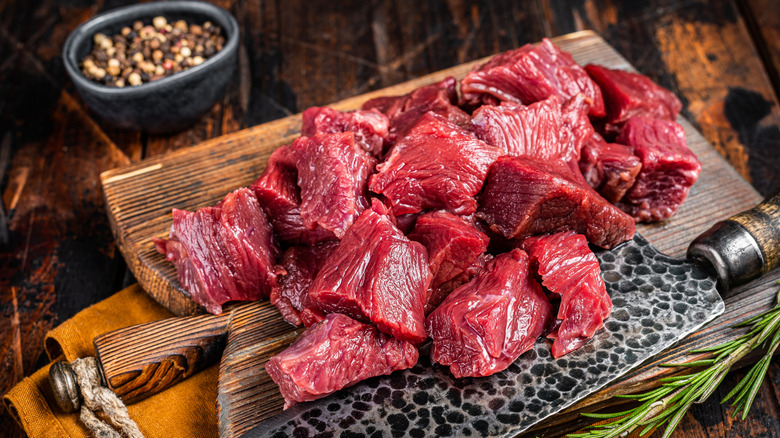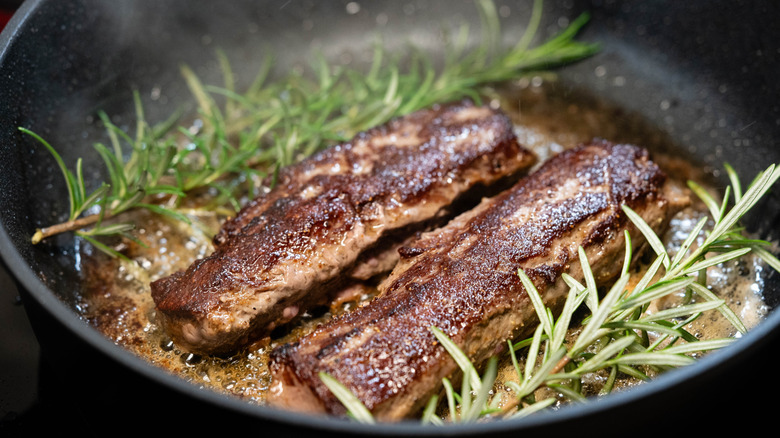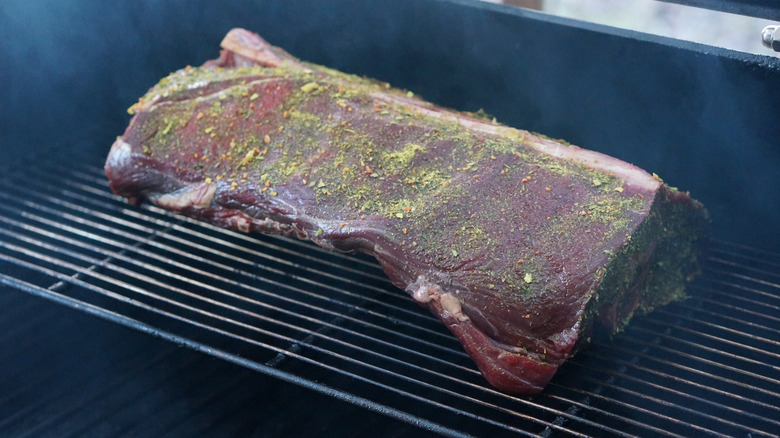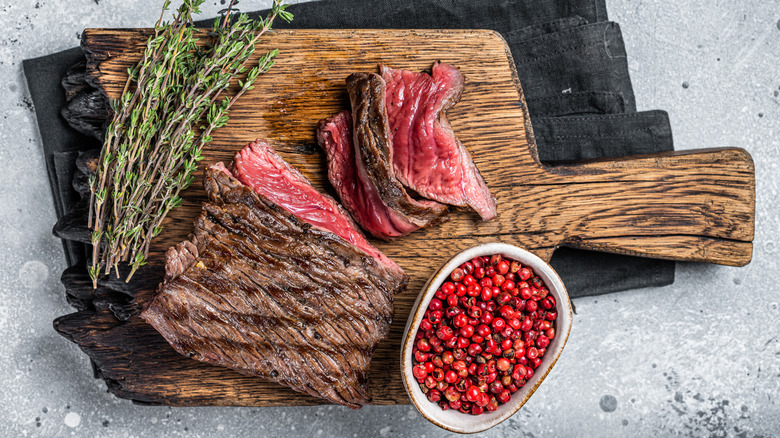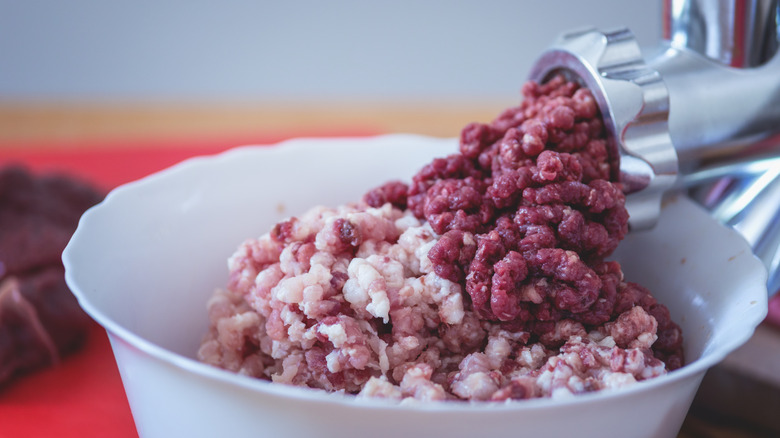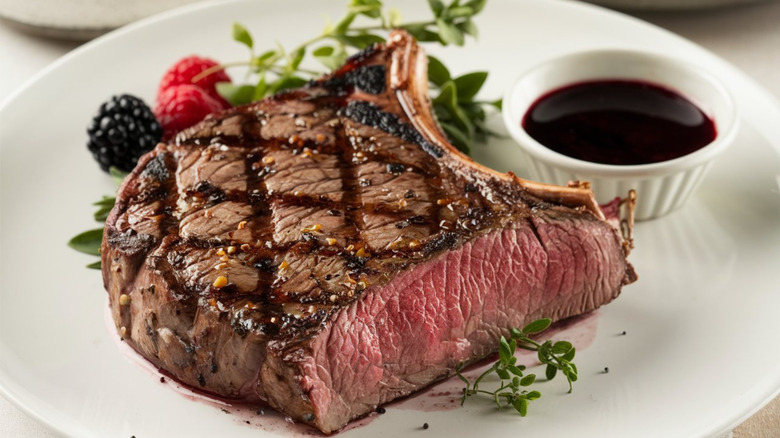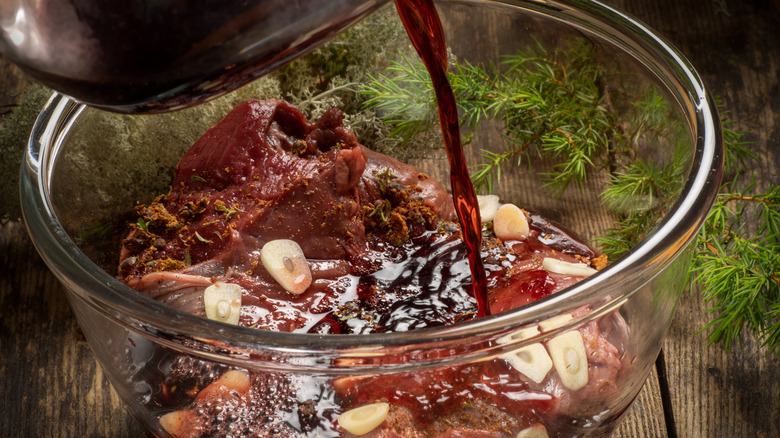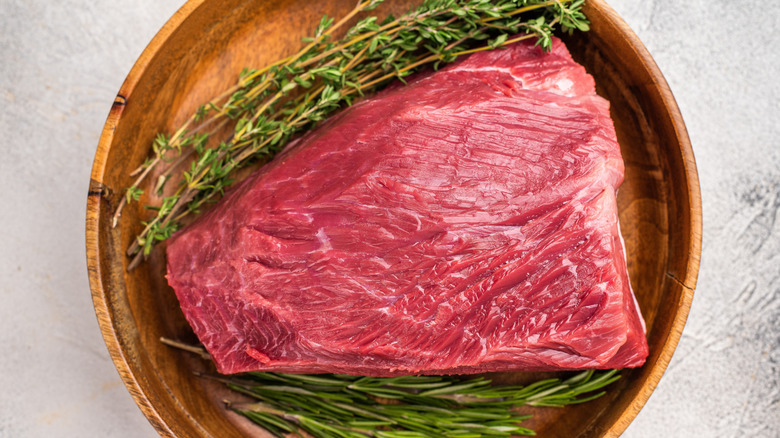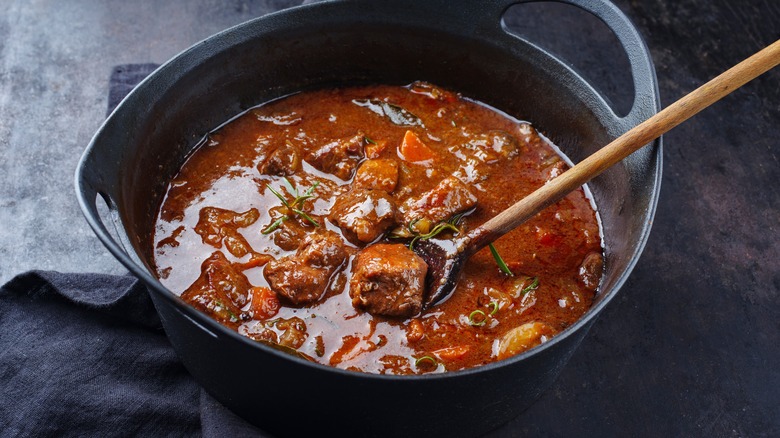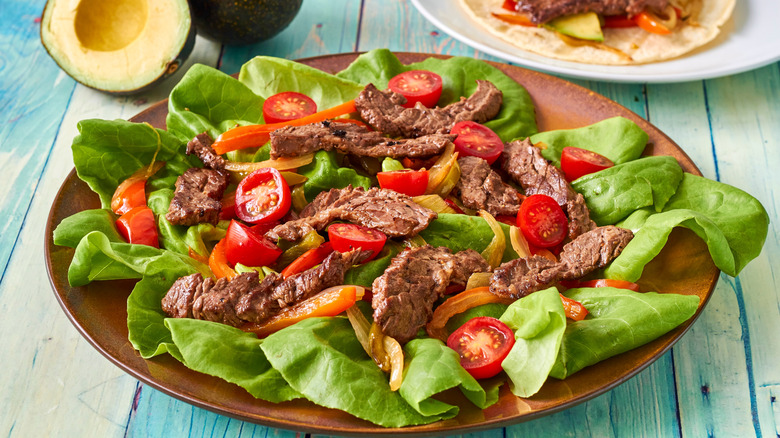11 Common Mistakes People Make When Cooking Venison
Depending on your state, deer hunting season typically starts around September and runs until February. While hunters may be restricted to the cooler months, the best time to try cooking venison is pretty much year-round. This is especially true for hunting families who bring home a bounty that lasts ages in the deep freezer, opening the possibilities to everything from a comforting venison mole chili to savory skewers on the barbecue.
To be fair, venison's flavor can be surprising — or even off-putting — to some, especially when you're used to farm-raised red meat. Deer lead far more wild lifestyles, foraging on vegetation and building muscles that are stronger and leaner. These natural habits result in meat that is rich in essential amino acids and low in fats and calories, but can taste "gamey" to the uninitiated.
If you're a meat enthusiast but have yet to try your hand at venison, it's time to expand your horizons. You might need to check out some local butchers to find the deer meat, but once you have it, you'll need to take some precautions before getting to work. Venison has unique properties and cooking considerations that separate it from other meats. To guide us through the most common mistakes when cooking venison, we've consulted a couple of deer meat enthusiasts, including food blogger Corrie Duffy from Corrie Cooks; and hunter and chef Nathan L. Judice, from Raised on Wild (@recreationalchef on Instagram). Check out their advice below, and avoid these slip-ups.
Overcooking venison
If it's your first time cooking deer meat without the supervision of the hunter in your family, our experts were unanimous on the most common slip-up for novices. "Overcooking is the biggest rookie mistake," chef and hunter Nathan Judice shared. "Venison, like most wild game, is very lean and without fat to baste it, it tends to dry out and become less tender with overcooking." Moreover, overcooking can intensify the deer meat's gamey flavor – the taste some people describe as rancid or acidic. The meat loses the richness from its fat over time, concentrating these striking natural flavors.
Of course, the risk of overcooking your venison will depend on how you're preparing it. Braising or stewing is a little more forgiving, but if you're pan-searing some prized cuts like tenderloin or backstrap, just one minute can make the difference between buttery and juicy or tough and stringy. "A meat thermometer is your best friend here," says food blogger Corrie Duffy. "Keep an eye on it and make sure you don't go past medium-rare."
According to the CDC, an internal temp of at least 145 degrees Fahrenheit (medium doneness) is the only way to ensure your meat is perfectly safe to eat. However, many enthusiasts would argue you're overcooking it and compromising the cut's integrity. Always ensure your venison has been properly stored and frozen, and when in doubt, stick to moist cooking methods to allow the game meat to reach a higher temperature and retain its juiciness.
Drying out the deer meat on the smoker
Smoking can turn those big, tough cuts of venison you've got tucked away in the freezer into succulent steaks. If you skip some crucial preparation steps, however, you run the risk of zapping all its moisture. Nothing hurts more than spending hours in front of the smoker only to serve up rubbery slabs of meat.
One consideration is choosing the best barbecue smoker, but you can't just slap the venison down and pray for the best. "Brine it first," Corrie Duffy encouraged. "A simple brine will help lock in moisture." Brining also helps the venison cook evenly and absorb more of that smokey goodness. It's as easy as soaking the meat soak overnight in a solution of ¼ cup of salt to one gallon of water. You can even soak the venison in milk or buttermilk to help achieve a milder flavor.
Regarding other practices to keep your meat tender, chef Nathan Judice recommended "wrapping the cut of venison in marinade or broth-soaked cheesecloth. This method helps with moisture retention, flavor infusion, and adds a permeable barrier that will help against direct heat and flare ups." Once you've prepped your venison, Duffy advised keeping the smoker's temperature low. "225 to 250 degrees Fahrenheit works great," he said. "I also like to wrap the meat in foil toward the end to keep it juicy." Judice agrees, suggesting brushing the venison with moisture and fat — like broth and butter — before wrapping it.
Seasoning venison with the wrong spices
Unless you're from a family of hunters, venison is probably more of a special treat than a typical weeknight meal, meaning you should do everything in your power to respect and savor the meat's novel flavors. If you're a little too liberal with the seasonings, for example, your deer meat will probably end up tasting like another everyday cut of red meat. While there's no shame in sticking to a reliable dash of salt and pepper, the key is using the right complementary flavors in moderation.
"I wouldn't go too heavy on things like cinnamon or cumin — those can overpower venison's natural flavor," Corrie Duffy advised. In a similar vein, Nathan Judice recommends avoiding sage spice blends. It may feel only natural to reach for these warmer, bolder spices for deer meat, but keep it to a pinch. They're distracting in excess, and could highlight the venison's gaminess a little too intensely. To bring out the gamey richness in the best way, "rosemary, thyme, juniper berries, and garlic work wonders with it," said Duffy.
Like most culinary rules, there's a lot of leeway depending on your taste and the specific dish. "As long as the salt, spice, and acidity are balanced then it should let the meat shine through," Judice said. "I like to pair venison steaks with a good pesto and balsamic marinade." Other pairings that offer strong and fatty flavors include dark-berry jams, herby butters, or blue cheese.
Using high heat to sear
Not all cuts of venison work well for searing, but for those that do, you need to carefully monitor the temperature of the meat and the pan. Tender cuts of deer meat – like backstrap and tenderloin –– have very little intramuscular fat to baste and tenderize them. "When searing, don't use super high heat," Corrie Duffy cautioned. "Keep it at medium-high to get a nice crust without losing moisture inside." A screaming hot pan could also burn your spices, accidentally overcook the meat, or encourage sticking, so use plenty of fat and a slightly lower temp to ensure even cooking. "I also like to baste the meat, following searing, with a couple tablespoons of butter," Nathan Judice suggested.
Regarding the best parts of the deer for searing, the backstrap is treasured by veterans and beginners alike, considered by some the filet mignon of venison. It's found along the deer's back, perfect for steaks, chops, and medallions. The tenderloin is right behind the backstrap and inside the ribs. "These cuts, along with the 'hidden tender' (eye of round), are prize cuts that are best cooked and served between medium and medium rare," Judice shared. "I tend to shoot for 125 degrees Fahrenheit, but anywhere between 120 and 135 degrees Fahrenheit will turn out great."
To further prevent these cuts from getting tough and dry, Judice told us to consider carryover cooking. "Remember during the resting period the internal temperature rises approximately five degrees," he said.
Skipping the extra fat for venison burgers
Venison burgers are a unique addition to the summer barbecue, especially when you have some shoulder, flank, or round cuts to use up. While showing off and smashing the meat into the grill may be one mistake you're making that's drying out your burgers, another is failing to add extra fat beforehand. When cooking venison, its fat content (or lack thereof) is always a factor you've got to consider. "Fat is key here," said chef Nathan Judice. "For burgers, I like to shoot between 15% to 20% added fat."
Although it seems counter-intuitive to fatten up what was supposed to be a leaner and healthier hamburger, additional fat will help your patties retain their shape instead of falling apart on the grill. Opposed to other binders like eggs, fat melts over the heat, distributing savory juices throughout the meat that prevent it from drying out. You could even get away with 10% added fat for leaner burgers that still pack plenty of flavor.
As for what type of fat to add, it really depends on your taste. "I prefer bacon ends, pork backfat, or brisket trimmings for a little extra flavor," Judice recommended. Most chefs steer clear of adding venison fat to ground meat as it's particularly waxy and gamey, whereas pork fat from the back or shoulder is firm and neutral. Pork belly and beef fat are softer but offer richer, beefier flavors, which some may find overpowering paired with venison.
Misunderstanding the gamey flavor
Tangy and musky might be some of the first descriptors that come to mind when eating venison — the flavor we've broadly come to call "gaminess." This gaminess can be especially striking if you're used to beef and pork, which are typically grain-fed and subtler. The taste of wild deer, though, reflects its natural diet of foraging on grasses, berries, leaves, and nuts.
If these earthy flavors start to taste too pungent — or even spoiled — the most common reason your venison tastes off originates long before cooking. "A lot of the gaminess comes from how the meat's handled right after the hunt," Corrie Duffy clarified. "If it's not properly field-dressed or aged, that strong flavor can take over."
Unless you're hunting your own deer, finding reputable venison vendors with transparent practices is your best bet. Nathan Judice explained that everything from how the deer was shot to how quickly it was cooled impacts the meat's final flavor. "In addition to that, if the subcutaneous fat is left on the meat, it can create a waxy texture and will develop a rancid flavor over time," he said. Apart from the subcutaneous fat, failing to remove the silver skin — that tough layer of connective tissue — can also contribute to an unpleasantly gamey cut of meat. If the venison is still a little too intense for you, try grinding it with pork fat into succulent sausages, or soaking it overnight in buttermilk before cooking.
Treating venison like beef
If it's your first time cooking venison, you'll probably resort to familiar cooking methods you've used with other types of red meat. However, "venison is much leaner, so it cooks differently," said Corrie Duffy. "If you cook it like beef or lamb (especially to higher temps), you risk drying it out." You might try to draw the comparison between venison and other leaner proteins, like chicken, but this is a mistake. "Chicken's fattier, so it's a little more forgiving, but venison needs more care," he said.
One way to take greater care is to avoid seasoning your venison like beef. Salting the deer meat too early could risk drawing out too much moisture. In most cases, though, the biggest risk in treating venison like beef is overcooking it. As a rule of thumb, aim to cook your venison to one level of doneness lower than how you prefer beef. "If it is overcooked in a 'dry cook,' it can become tough and can enhance the iron-rich flavor," chef Nathan Judice pointed out.
You'll have to tweak your technique even more with wild deer meat, since hunted venison is leaner and packs more of this iron-rich punch than commercially-available cuts. Parboiling the meat with whole spices before braising or stewing is one trick that can help reduce gaminess and maintain a tender texture. You should also stew venison lower and slower than beef as it's so lean.
Going overboard with the marinade
While marinating venison can certainly help tenderize and mellow its gaminess, you need to set some limits. The first question you should ask is if your cut even needs a marinade. "I typically don't marinate backstrap and tenderloins, as the meat speaks for itself," said Nathan Judice. "High heat, salt, pepper, and basting in some butter is all it needs." On the other hand, "tougher cuts, like shoulder, can benefit from longer marinades," Corrie Duffy advised. "Just don't overdo it, though, as too much marinating can break down the texture."
You'll find a lot of recipes for venison marinades with acidic ingredients like vinegar, wine, orange juice, or tomatoes. These bold and tangy flavors complement the deer's funk, but you'll learn your lesson quickly if you let the meat marinate too long. Judice recounted a time when his fresh pineapple and habanero marinade for venison sausages went awry: "I ground the pineapple into the meat then seasoned it and stuffed it into links. I let the links dry in the refrigerator overnight prior to smoking the next day. This allowed the bromelain enzyme in the pineapple to break down the meat proteins enough so that the sausage was very liquid and mushy. I had to throw the five-pound batch of sausage away because it was inedible."
For acidic marinades that contain bromelain — like in fresh pineapple — Judice recommends cooking the venison immediately after marinating. Alternatively, cook the marinade separately to destroy the enzyme.
Removing all of the deer meat's fat
The fat on deer meat is one reason why venison has such a distinct flavor. Even though deer are incredibly lean, their fat delivers high concentrations of stearic acid – a fatty acid that can taste oily and unpleasant. Before you remove every sliver of fat, however, some of it is actually beneficial. "For steaks and chops, you can trim excess fat, but don't remove it all," Corrie Duffy said. "Fat adds a lot of flavor and moisture, so I usually recommend leaving some on, especially when making burgers."
This good fat is intramuscular fat — those white ribbons that run through the meat. Chef Nathan Judice mentioned that the only consideration with softer intramuscular fats is "they do become rancid over time in the freezer, much more so than beef or other animals." Depending where you source your venison, you might also find thicker, exterior chunks of fat hanging onto the cuts. "Hard subcutaneous fat can cause a waxy texture in your mouth and harden up like candle wax once it is cooled," Judice explained. "This fat should be removed as it will add a very off flavor to your dish."
If you notice a corner of fat and can't identify whether it will add or subtract from your dish, render a bit with some water in a pan. If the aroma is pleasant, chances are it'll taste good.
Using dry heat for the tougher cuts of venison
Before you start preparing your venison, consider how the deer's lifestyle can affect your cooking. Other red-meat animals like pigs and cows live at a slower pace, allowing them to develop fattier muscles that make cooking more forgiving. Deer, however, are agile, building stronger neck, shoulder, and leg muscles that require a little more finesse to prepare correctly.
While slicing some steaks and throwing them onto the frying pan is quick and easy, certain cuts of venison cannot handle the high heat. "Tougher cuts, like shoulder or shank, are better for slow cooking or braising," Corrie Duffy explained. "They need more time to break down and become tender." Nathan Judice agreed that the tough cuts are a great opportunity to pull out your "low and slow" techniques, like braising. Just like high heat can dry out tougher cuts, slow roasting the leanest cuts can strip them of any moisture. "Grill or sear cuts like backstrap, tenderloin, and rip chops –– they're perfect for high heat," Duffy said.
Thanks to the active habits of deer, the connective tissue in venison can also be quite tough, especially in the muscles that get the most use. The type of cut — and your cooking methods — will determine whether to remove this sinewy "silver skin." As a general rule, you should peel off the connective tissue before searing tender cuts, but for wet cooking methods, it will melt into a silky gelatin and help the meat retain moisture.
Sticking to one cooking method
Once you've gotten a feel for preparing venison, don't be afraid to get adventurous. Cooking deer meat is undoubtedly nuanced, but one of our biggest mistakes is failing to really experiment with its unique and nutty flavors. Sauté medallions for some venison fajitas, for example, or marinate and skewer backstrap for kebabs. If you've bagged an older, tougher buck, thinly slice and dehydrate strips of round for flavorful venison jerky. The possibilities are wide open — just avoid drying out the cuts with a sear that's too hot and fast, or turning them to mush by over-marinating.
We asked our experts about some of their favorite venison cooking techniques. "Sous vide is an underrated method," suggested Corrie Duffy. "It gives you precise control over the temperature, resulting in perfectly tender venison." As long as you have Ziploc bags and a pot at home, you can even sous vide without a vacuum sealer.
"Braising tough cuts for a long time, such as osso bucco" is another overlooked technique, according to Nathan Judice. "When the tendons and marrow break down through the long cooking process it makes for a rich and velvety sauce." Braising venison osso bucco – the lower part of the shank — is a famed Italian recipe that involves cooking the cut low and slow with a medley of fresh herbs, veggies, and wine for an unctuous hearty meal.
